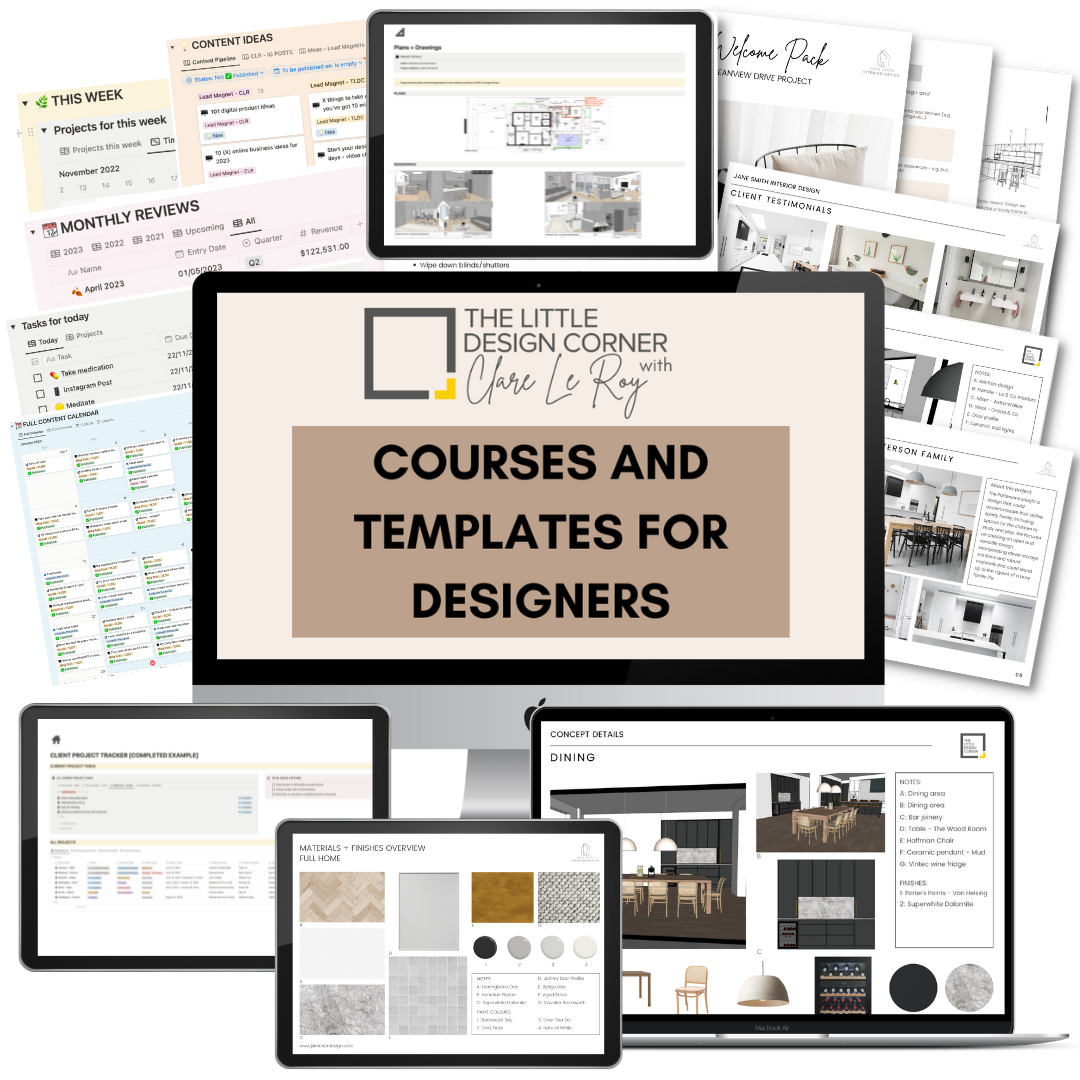Advice from 10+ years of running my design business
I’ve had my design business for more than 10 years and most of those years were spent doing exactly the same type of work that most of you do - i.e. working 1:1 with design clients on their home renovation projects.
Here are some random tips and advice I’ve learned up over the past 10+ years that you may find helpful:
Embrace the business side as much as the creative side - lots of designers struggle with the transition from creativity to entrepreneurship and forget that if you are going to run a business you will likely be working more on the business side than on the creative (design) side. This isn’t what many designers are good at so it may not be the right fit for everyone. Sometimes it’s OK to be the best designer in someone else’s business and let them worry about the business side of things and finding the next clients.
Master the art of managing client expectations. Miscommunication about timelines, budgets and design vision can cause lots of issues. Develop a clear and thorough onboarding process that aligns expectations from day one. I would recommend a client welcome pack as part of this onboarding process.
Build a network of reliable tradespeople and suppliers. Your reputation hinges on more than just your designs. Build strong relationships with quality professionals who can partner with you on projects.
Learn to say "no" to bad fit projects. Turning down difficult clients or low quality projects will protect your time, energy and brand. Not every client is a good fit - and that’s totally fine.
Develop a system for handling design revisions. Endless tweaks can eat into your profits. Establish clear boundaries around your revision process in your contracts and reiterate these in client communications. Two rounds of changes is pretty standard in most design contracts.
Invest in professional photography. Don't skimp on high quality images (for projects that are worth investing in). You need to be able to show potential clients the quality of your work. For lower quality projects spend time learning how to take good photos yourself. This will then make good content for social media or Instagram stories.
Master sales skills without being pushy. Learn how to tell stories that sell your business and services in a way that benefits both you and the client. This is about learning how to sell your value.
Design is personal. Learn to navigate client emotions, especially when dealing with couples with conflicting visions. You will need to become part marriage counsellor! Learning some basic psychology can help you with this.
Juggling multiple projects requires really solid organisational skills. Find tools and processes that keep you on track without stifling your creativity. My template library can help you.
Price your services based on value, not just time Hourly rates will undervalue your expertise and punish you for being efficient.
Social media will help position you as a thought leader and attract ideal clients - but you you have to put in the work to learn how to do this well. Bad social media will discourage clients. Put in the work to learn.
When you’ve got the funds to do so start outsourcing your drawings (2D/3D/renderings) plus repetitive work like bookkeeping and admin to free up more time for design and client interaction.
Develop a comprehensive understanding of building codes and regulations. Stay ahead of legal requirements to avoid mistakes. This also positions you as a knowledgeable expert.
The end of a project is as important as the beginning. Develop systems for smooth handovers, final walkthroughs and gathering testimonials. A handover pack may be helpful here.
Your home can be a great advertisement for your business. Use it to experiment with ideas - I tend to find I can be a bit more creative with my own home.
Have a plan for addressing unrealistic demands, budget issues or personality clashes with clients (before they derail projects!)
Learn the art of lighting design
Learn the art of space planning
Regularly refresh your portfolio and update your website and social media with new projects (this can get forgotten when you start to get busy and your website quickly becomes stale and full of old projects that no longer reflect your style and current work).
Create a signature client gift but DON’T put branding on these gifts - it looks naff and most clients won’t want to display it.
Develop partnerships with art galleries or local artists Curating unique, custom pieces can set your designs apart and support your local creative community
Sometimes clients have underlying motivations (like impressing neighbours/family) that they don't articulate. Learn to read between the lines and address unspoken needs. This comes abck to learning about psychology of sales. A good book for this is “Influence” by Robert Cialdini.
Mediating between spouses or family members with conflicting tastes can be really annoying. Develop diplomatic skills to handle these situations
Develop confidence in pricing your creative problem solving skills, not just your time. Learn about value based pricing and start implementing these strategies ASAP.
Thanks for reading and catch you in my next post :)
Clare x
Dr Clare Le Roy
Courses and Templates for Designers and Architects
DO YOU WANT TO….
Improve your professionalism?
Find more clients?
Bring in more revenue?
Create better systems and processes?
Then check out my business courses and templates for designers and architects.
These courses and templates leave you with work done - not just a long list of things you need to do next. We have a really strong focus on taking action and getting things created that improve your business.








